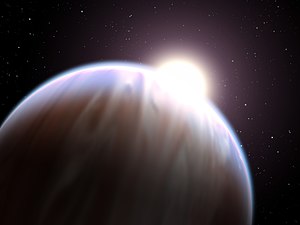WASP-121
| Observation data Epoch J2000.0 Equinox J2000.0 | |
|---|---|
| Constellation | Puppis[1] |
| Right ascension | 07h 10m 24.0595s[2] |
| Declination | −39° 05′ 50.562″[2] |
| Apparent magnitude (V) | 10.4 |
| Characteristics | |
| Spectral type | F6V[3][4] |
| Apparent magnitude (B) | 11.00[2] |
| Apparent magnitude (V) | 10.51[2] |
| Apparent magnitude (J) | 9.625[2] |
| Apparent magnitude (H) | 9.439[2] |
| Apparent magnitude (K) | 9.374[2] |
| Astrometry | |
| Radial velocity (Rv) | 38.4±0.4 km/s |
| Proper motion (μ) | RA: −3.735[5] mas/yr Dec.: 25.663[5] mas/yr |
| Parallax (π) | 3.7996 ± 0.0104[5] mas |
| Distance | 858 ± 2 ly (263.2 ± 0.7 pc) |
| Details | |
| Mass | 1.353[3] M☉ |
| Radius | 1.458[3] R☉ |
| Temperature | 6,460.0[3] K |
| Metallicity [Fe/H] | 0.13[3] dex |
| Rotational velocity (v sin i) | 11.90±0.31[6] km/s |
| Other designations | |
| Database references | |
| SIMBAD | data |
| Extrasolar Planets Encyclopaedia | data |
WASP-121, also known as CD-38 3220, is a magnitude 10.4 star located approximately 850 light-years away in the constellation Puppis.[1] WASP-121 has a mass and radius similar to the Sun's. Its planet WASP-121b orbits around WASP-121 in about 1.27 days.[3] WASP-121b is the first exoplanet found to contain water in an extrasolar planetary stratosphere (i.e., an atmospheric layer in which temperatures increase as the altitude increases).[7][8]
Planetary system[]

In 2015, the extrasolar planet WASP-121b was discovered orbiting WASP-121 by the transit method.[3][9] WASP-121b is a "hot Jupiter" exoplanet with a mass about 1.18 times that of Jupiter and a radius about 1.81 times that of Jupiter.[4][7] The exoplanet orbits WASP-121, its host star, every 1.27 days.[4][7] Hot water molecules have been found in the stratosphere of WASP-121b.[3][7][8][10]
| Companion (in order from star) |
Mass | Semimajor axis (AU) |
Orbital period (days) |
Eccentricity | Inclination | Radius |
|---|---|---|---|---|---|---|
| b | 1.184[3][4] MJ | 0.02544[3] | 1.275[3] | 0.0[3] | 87.6[3]° | 1.81[4] RJ |
Gallery[]

See also[]
References[]
- ^ a b Staff. "Finding the constellation which contains given sky coordinates". djm.cc. Retrieved 3 August 2017.
- ^ a b c d e f g h "WASP-12". SIMBAD. Centre de données astronomiques de Strasbourg. Retrieved 3 August 2017.
- ^ a b c d e f g h i j k l m Staff (2015). "Planet WASP-121 b". exoplanet.eu. Retrieved 3 August 2017.
- ^ a b c d e Staff (2017). "WASP Planets". wasp-planets.net. Retrieved 3 August 2017.
- ^ a b c Brown, A. G. A.; et al. (Gaia collaboration) (2021). "Gaia Early Data Release 3: Summary of the contents and survey properties". Astronomy & Astrophysics. 649: A1. arXiv:2012.01533. Bibcode:2021A&A...649A...1G. doi:10.1051/0004-6361/202039657. S2CID 227254300. Gaia EDR3 record for this source at VizieR.
- ^ Borsa, F.; Allart, R.; Casasayas-Barris, N.; Tabernero, H.; Zapatero Osorio, M. R.; Cristiani, S.; Pepe, F.; Rebolo, R.; Santos, N. C.; Adibekyan, V.; Bourrier, V.; Demangeon, O. D. S.; Ehrenreich, D.; Pallé, E.; Sousa, S.; Lillo-Box, J.; Lovis, C.; Micela, G.; Oshagh, M.; Poretti, E.; Sozzetti, A.; Allende Prieto, C.; Alibert, Y.; Amate, M.; Benz, W.; Bouchy, F.; Cabral, A.; Dekker, H.; D'Odorico, V.; et al. (2021), "Atmospheric Rossiter–Mc Laughlin effect and transmission spectroscopy of WASP-121b with ESPRESSO", Astronomy & Astrophysics, 645: A24, arXiv:2011.01245, Bibcode:2021A&A...645A..24B, doi:10.1051/0004-6361/202039344, S2CID 226237425
- ^ a b c d Landau, Elizabeth; Villard, Ray (2 August 2017). "Hubble Detects Exoplanet with Glowing Water Atmosphere". NASA. Retrieved 2 August 2017.
- ^ a b Evans, Thomas M.; et al. (2 August 2017). "An ultrahot gas-giant exoplanet with a stratosphere". Nature. 548 (7665): 58–61. arXiv:1708.01076. Bibcode:2017Natur.548...58E. doi:10.1038/nature23266. PMID 28770846. S2CID 205258293.
- ^ Delrez, L.; Santerne, A.; Almenara, J.-M.; Anderson, D. R.; Collier-Cameron, A.; Díaz, R. F.; Gillon, M.; Hellier, C.; Jehin, E.; Lendl, M.; Maxted, P. F. L.; Neveu-Vanmalle, M.; Pepe, F.; Pollacco, D.; Queloz, D.; Ségransan, D.; Smalley, B.; Smith, A. M. S.; Triaud, A. H. M. J.; Udry, S.; Van Grootel, V.; West, R. G. (2015), "WASP-121 b: A hot Jupiter close to tidal disruption transiting an active F star", Monthly Notices of the Royal Astronomical Society, 458 (4): 4025–4043, arXiv:1506.02471, doi:10.1093/mnras/stw522
- ^ Mikal-Evans, Thomas; Sing, David K.; Kataria, Tiffany; Wakeford, Hannah R.; Mayne, Nathan J.; Lewis, Nikole K.; Barstow, Joanna K.; Spake, Jessica J. (2020). "Confirmation of water emission in the dayside spectrum of the ultrahot Jupiter WASP-121b". Monthly Notices of the Royal Astronomical Society. 496 (2): 1638–1644. arXiv:2005.09631. doi:10.1093/mnras/staa1628. S2CID 218684532.
External links[]
Coordinates: ![]() 07h 10m 24.0s, −39° 05′ 51″
07h 10m 24.0s, −39° 05′ 51″
- Puppis
- Planetary systems with one confirmed planet
- Planetary transit variables
- F-type main-sequence stars
- 2MASS objects
- Durchmusterung objects
- TESS Objects of Interest